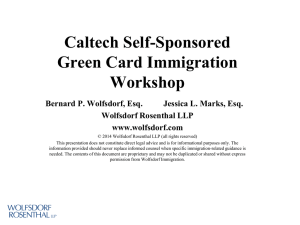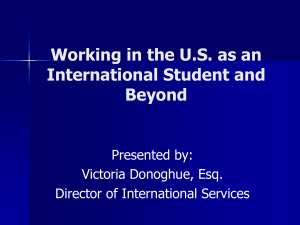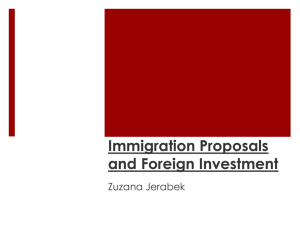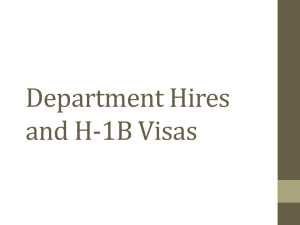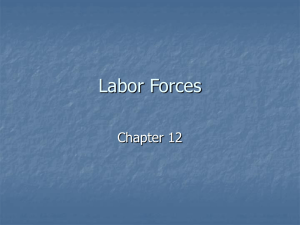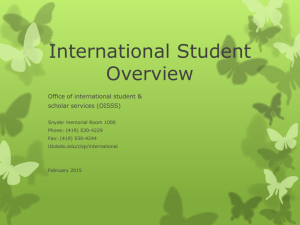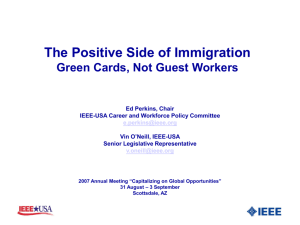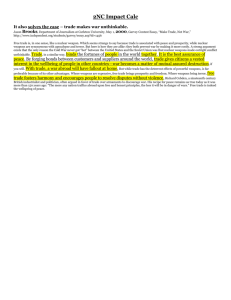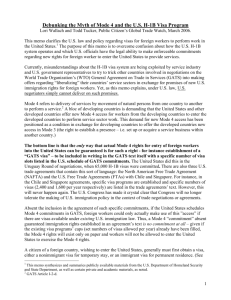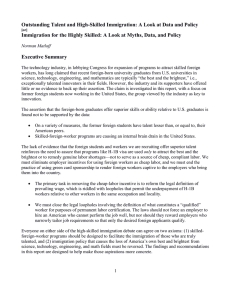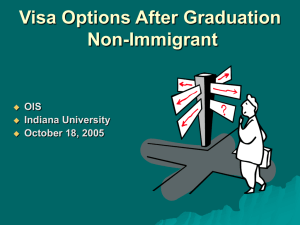2013 Annual Conference - National Association of College and
advertisement
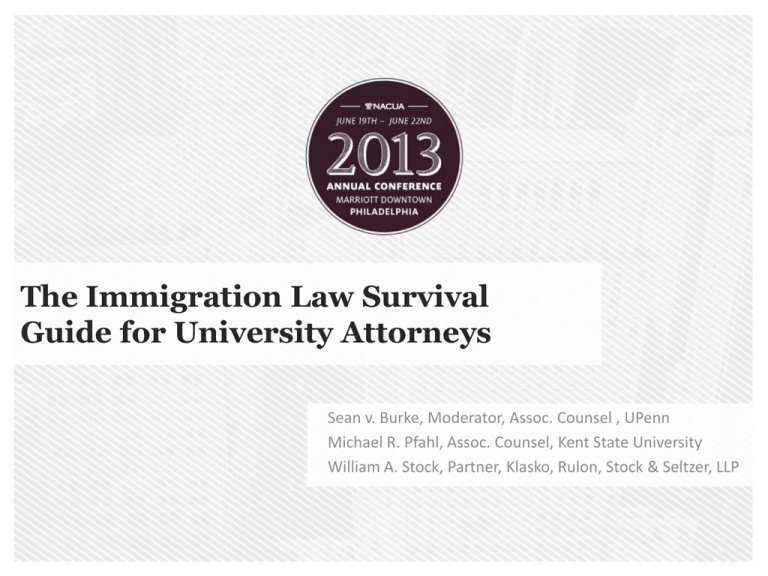
The Immigration Law Survival Guide for University Attorneys Sean v. Burke, Moderator, Assoc. Counsel , UPenn Michael R. Pfahl, Assoc. Counsel, Kent State University William A. Stock, Partner, Klasko, Rulon, Stock & Seltzer, LLP Immigration: an issue on every campus • • • • • • • • Students Exchange visitors Researchers Staff Faculty Artists/Musicians Coaches Speakers The Lingo: Basic Concepts/Terms • Immigrant: a foreign national who intends to establish a permanent residence in the U.S. • Nonimmigrant: a foreign national who intends to enter the U.S. on a temporary basis, without intent to reside permanently. • Green card: The informal name of the card issued as proof of registration as a legal permanent resident. (Is no longer green). • Visa vs. Work Authorization: The visa provides for permission to enter and reside, but does not always provide for work authorization. The University: Sponsoring Employer Specific Purposes • F-1 Visa • J-1 Visa • H-1B Visa • O-1 Visa • Green Card Specific limitations • Must be enrolled (or OPT) • Limited term/Bars to reentry • Limited term/location specific • Only available for top performers • Advertisement for job is key for EB-2/3, high standard of review for EB-1 The Visa: H-1B Points of exposure • Labor Condition Application – Prevailing Wage determination – 10-day Notice and Retention (including union notice) – Documentation of the position • Public Access File – Keep it separate – Integrate into your retention schedules The Intake: Just the facts… lots of them • A fact-intensive process deserves a fact-intensive intake (probably more intense than your application). • Previous visa statuses • Previous visits • Any restrictions • Any dependents • In or out of the country? The Term: Full-time, part-time, short time? • H-1B visa can be: – Full-time or part-time. – One day to 3 years (with a maximum of renewals to six years under normal circumstances). – Employer-specific. – Can hold multiple H-1Bs at the same time. • Common question: How soon can the person start? The Wage: DOL survey vs. other • DOL Survey: OES Wage Survey, OFLC Online Data Center. • University survey options: – OES wage Survey – Other Accepted Industry survey – In-House compensation determination • Must be supported by survey that meets several requirements. • Issue: When do you file for prevailing wage determination through the DOL (i-Cert system)? The Record: What goes where & for how long? • Public Access File: one year after the expiration of the LCA, or one year after termination of the LCA whichever occurs first. • Other forms: – Form I-129, H-1B petition. – Form I-797 Notice of action. – RFEs, Appeals, Etc. • Retention: Anywhere other than the employee’s personnel file! Centrally located and consistently applied. (Destruction also must be monitored!) The End: Termination of the H-1B • End of the term, no renewal: no duties • Employee decides to leave: withdrawal the LCA, send letter terminating the visa to USCIS. • Employer decides to terminate employee before term: withdrawal the LCA, send letter terminating the visa to USCIS, and offer the employee “transportation costs to his/her last place of foreign residence. • Question: What if the employer lays off the employee for a short period? The Green Card: The road to PR The Petitioner: Who supports the petition? • University as petitioner: – File the PERM on behalf of the employee – File the I-140 (EB-2/3) on behalf of the employee – File the I-140 (EB-1) on behalf of the employee • Employee as petitioner: – National Interest Waiver – I-140 (EB-1) Alien with Extraordinary Ability The Process: Basic vs. Competitive • Basic Recruitment – Specific advertising methods and content. – Limited time period: 180 days. – Standard: no other U.S. Worker applicant is able and qualified for the job opportunity, nor could any applicant acquire the skills necessary to perform the duties during a reasonable period of on-the-job training. The Process: Basic vs. Competitive (cont) • Competitive Recruitment – Limited to positions involving “classroom teaching.” – Period from Offer to Filing cannot be longer than 18 months. – Standard: “more qualified” that any U.S. worker applicant. • Continuing decisions from BALCA make this an ever-evolving component of immigration The Exceptions: Outstanding Professors • Referred to as “EB-1” or “Employment-Based immigration, First Preference.” • What is “outstanding” and how do you prove it? • Issue: What about these letters of support that the University is being asked to write? What is a “permanent position”? The Check: Who writes it and for how much? • From I-129, H-1B: ($325, $500) Employer must pay the fees associated with the H-1B in most cases (the prevailing wage/actual wage conundrum) • PERM: Employer is responsible for costs associated with the PERM process. • Form I-140, Petition for Immigration Worker: ($580) Determined by policy. The Expert: Working with outside counsel • Whom does Outside Counsel Represent – the University, the employee or both? • Who does the selecting, versus who does the retaining? • Factors in vetting outside counsel – Knowledge of higher education and the university’s policies – Experience & reputation in the field – Costs and who bears them Outside Counsel Program • Limit selection of counsel to firms preapproved by university counsel • Establish fees • Post policy on payment of fees (department versus beneficiary) • Post FAQ’s I-9: General Principles • Employer must verify the employment eligibility of all employees hired after November 6, 1986. • Employer must retain I-9s for 3 years after employee begins work or 1 year after date of termination – whichever is later. • Treat all employees the same. • Do not commit fraud. Common Pitfalls • Failure to complete the I-9 • Document information not recorded in Section 2 • Overdocumentation in Section 2 • Date of hire not provided • Keeping I-9s too long • Treating “foreign” employees differently when completing I-9 • Failure to reverify • Preparer does not sign I-9 as required • Inconsistencies Citizenship Status Discrimination • No Discrimination Allowed Between U.S. Citizens, U.S. Nationals, Permanent Residents, Asylees, Refugees, and 1986 amnesty program’s “Temporary Residents.” • Recruiters NOT allowed to ask “Are you a U.S. Citizen?” or “Do you have a Green Card?” • Recruiters NOT allowed to request specific documents or to require “more or different” documents than the minimum required. • Recruiters ARE allowed to ask if an applicant is authorized to work in the U.S., or may need sponsorship for employment visa status (e.g. H1-B). Recruitment Questions About Immigration Status • Employers May Elect Not to Hire Candidates Needing “Immigration Sponsorship.” • Policy: Employees will be sponsored where there is a valid business reason (i.e. unavailability of other qualified candidates). • Recruiters ARE allowed to ask “Are you legally authorized to work in the United States?” followed by “Will you now or in the future require sponsorship for an employment visa status (e.g., H-1B visa status)?” • Policy: Once a candidate indicates he or she will need sponsorship, recruiter should request details of the candidate’s status and immigration history, and forward to HR before an offer is made. S. 744 – What would it do? The Headlines • Legalization – 10 year “path to residency” contingent on border “triggers” • Reallocate family immigration: spouses and children of LPRs will be immediate relatives; brothers and sisters of USCs will be eliminated. Married sons & daughters of USCs cut off at 31 years old. S. 744 – What would it do? The Headlines • Temporary Workers: Add a “W-1” category to supplement current H-2B; replace H-2A (Ag Workers) with new “W-2” and “W-3” visas • E-Verify: mandatory for all employers after 5 years • Border Security: additional funding for physical and electronic infrastructure; sets “triggers” of 100% surveillance and 90% apprehension in “high risk” areas for illegal crossing S. 744 – Employment based Immigration Provisions – The Good News • Permanent: – Exempts EB-1 immigrants, all doctoral degree holders, and physicians with 212(e) waivers from the EB quotas – Exempts all derivative beneficiaries from the EB quotas – Adds new “startup” green card for entrepreneurs who attract investment to their business from venture capital – New “STEM” Green Card for recent Master’s degrees S. 744 – H-1B Provisions: The Bad News • H-1B Dependent Employers must offer above market wages, may not place workers with other employers, and face other limits • All H-1B employers will be required to place a 30 day job order with DOL prior to filing an LCA and attest that no “equally or better qualified” US worker applied in that period • LCAs reviewed by DOL for 14 days and can be denied for “evidence of” fraud S. 744 – H-1B Provisions: The Bad News • OES wage levels would be increased and would be mandatory – no private surveys unless no OES data • For universities, 4 level wage system retained for teaching and research positions only • Nondisplacement attestation for most employers (no layoffs w/in 90 days prior and 90 days after H-1B) What Happens After S.744? • House of Representatives will consider immigration bill or bills over the summer • Committee hearings and markups likely not done before August recess • House needs to pass some immigration related bill, will then go to Conference Committee • Conference Committee’s bill will face up-or-down vote in Senate and House • If passed, President must sign
